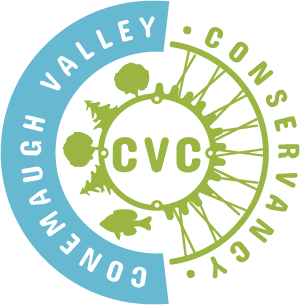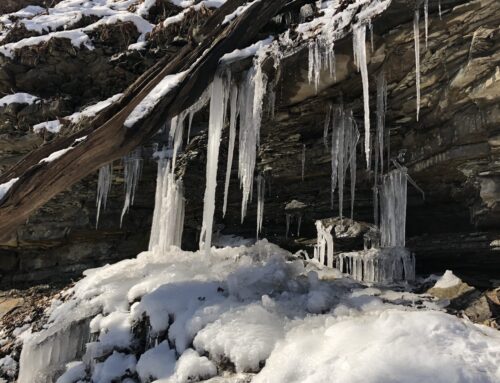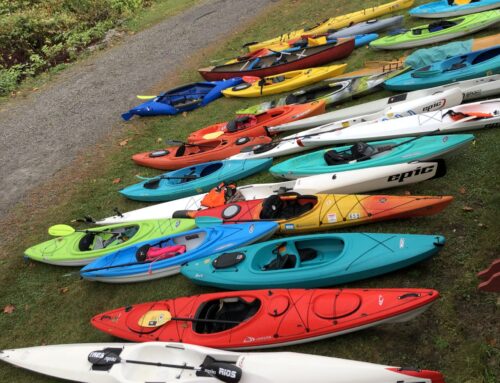Welcome to the 25th anniversary year of the Conemaugh Valley Conservancy! While we have certainly seen some milestone CVC projects come to fruition over the past 25 years, there is one warm, fuzzy, feelgood chapter to CVC’s memoirs that has yet to be written, but soon that may change.
Back in the day (1994 to be exact) the CVC was looking at logos and came up with Conemaugh Connie the river otter. Okay, you may be saying to yourself, “I get the CONEmaugh CONNIE part, but why an otter?” Well, it just so happens that the name Conemaugh or Connumach means ‘Otter Creek’, originating from the Unami-Lenape language word kwənəmuxkw ‘otter’.
The story of the resurgence of river otters in North America is one of the greatest success stories of modern wildlife conservation. Prior to 1900, degradation of water quality and habitat, human encroachment, and unregulated harvest led to a 75% decline in North American otter populations {U.S. Fish and Wildlife}. As a result of dedicated efforts of concerned biologists and state wildlife agencies, reintroduction efforts, legal protection, improved habitat quality and regulated harvest, otter populations rebounded during the mid- to late 1900s.
While otters were never officially listed as extirpated in the state of Pennsylvania, their numbers had dwindled significantly. In the Conemaugh, over-trapping, un-wise harvesting of timber, and rampant coal mining lead to the demise of the otter population in the Conemaugh watershed due to loss of habitat and clean water.
Fast forward to the late 1990’s and enter Dr. Tom Serfass. Dr. Serfass is Chair and Professor of Wildlife Ecology in the Department of Biology and Natural Resources at Frostburg State University, and Adjunct Professor at the Appalachian Laboratory – University of Maryland (College Park) Center for Environmental Science. A large portion of his research and conservation activities have focused on the design, implementation, and evaluation of wildlife restoration programs and recovering wildlife populations—particularly mesocarnioves. Tom conceived and coordinated the successful Pennsylvania River Otter (Lontra canadensis) and Fisher (Martes pennanti) Reintroduction Projects, and has authored over 40 journal, proceedings, popular articles, and book chapters dealing specifically about river otters, fishers, and wildlife reintroductions {Frostburg State University}.
What does this professor have to do with the Conemaugh River? Well, as it turns out, Dr. Serfass actually looked at reintroducing the river otter to the Conemaugh in the late 1990’s, only to determine that the water was unfit for otter reintroduction at that time. Since the CVC has always been the type of organization to never take “no” for an answer, we’re bringing in Dr. Serfass to take another look at our waterways and all of the exciting improvements that have been completed over the past 20 years since he has been here.
Dr. Serfass will be our Guest Speaker for the CVC annual meeting at 6 p.m. May 14 at Johnstown Heritage Discovery Center. Hopefully he and his team will be arranging a future assessment of the Conemaugh to determine:
- Have otters already found their way into the watershed?
- If so, can we advance otter habitation by bringing some otters into other parts of the watershed?
- If not, can we re-introduce otters and if so, where are the optimal locations to do this?
We hope to engage our current and former Stream Team volunteers, paddlers, and others familiar with the river to tell us if they’ve seen evidence of otters in the Conemaugh or tributaries. Evidence could be actual sightings of otters OR maybe people have seen “latrines,” which are unique to these critters and a good indicator that they are around. This could make it much easier to determine what we have and what our next steps could be in creating or expanding otter habitation within the Conemaugh watershed.
So, why deal with the hassle of bringing a warm, fuzzy otter back to the Conemaugh? An otter presence is terrific news for a rebounding watershed because otters need healthy fish, reasonably clean water and enough space to raise young otters to thrive. A reintroduction of otters to the watershed is an amazing visual bio-indicator that instantly demonstrates to the average person the improvements we’ve made to our local waterways. Eagles, heron, osprey, trout, bass, walleye and others have all begun to call the Conemaugh River their home, so why not let the species for which the Conemaugh was named after have a shot at coming home again! C’mon home, Connie!






